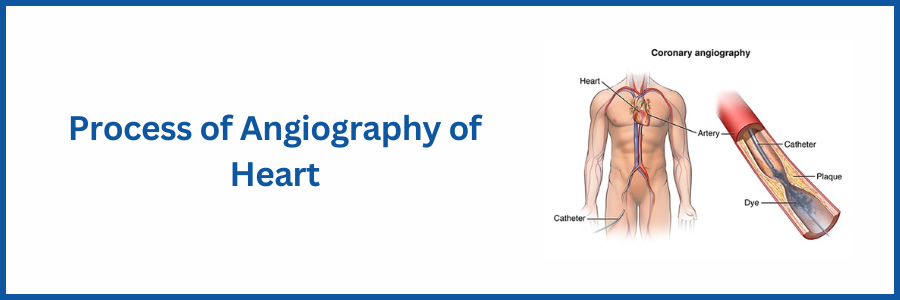- Cardiology 84
- Dermatology 45
- Endocrinology 33
- ENT 16
- Fertility 190
- Gastroenterology 78
- General-Medicine 81
- Gynecology 80
- Hematology 19
- Infectious-Diseases 33
- Neurology 52
- Oncology 34
- Ophthalmology 23
- Orthopedics 69
- Pediatrics 31
- Procedure 23
- Public-Health 144
- Pulmonology 59
- Radiology 8
- Urology 68
- Wellness 161
- Woman-and-child 77

Angiography of the Heart: Process and Procedure
Heart angiography, also known as coronary angiography, is a specialized medical procedure used to visualize the coronary arteries, which supply blood to the heart muscle. This diagnostic test is crucial for assessing the presence of blockages, narrowing (stenosis), or other abnormalities that may affect heart function.
What is Angiography of the Heart?
Angiography of the heart is a crucial imaging method used to visualize the internal structures of the heart, particularly the coronary arteries. It plays a pivotal role in diagnosing various cardiovascular diseases. This article provides a comprehensive overview of heart angiography, its process, and procedure steps.
What is the Process of Angiography?
The process of heart angiography involves several key steps:
- Preparation: Before angiography, patients may need to fast for several hours to ensure clear imaging. In some cases, a sedative is administered to enhance comfort during the procedure.
- Insertion of Catheter: A long, thin catheter is inserted into a large artery, typically in the groin or sometimes the wrist. Guided by fluoroscopy (live X-ray imaging), the catheter is carefully navigated to the coronary arteries.
- Contrast Injection: Once the catheter is positioned correctly, a contrast dye is injected into the coronary arteries. This dye highlights the blood vessels, allowing them to be visible on X-ray images.
- Angiography Procedure Steps: Rapid X-ray images are then captured as the contrast dye flows through the coronary arteries. These images help cardiologists assess blood flow patterns and identify any blockages or abnormalities.
- Post-Procedure Care: After the angiogram is complete, the catheter is removed, and pressure is applied to the insertion site to prevent bleeding. Patients are typically monitored for several hours to ensure there are no complications.
Conclusion
Heart angiography is essential in cardiovascular medicine, providing critical insights into the health of the coronary arteries. Despite its brevity, this procedure enables cardiologists to make accurate diagnoses and plan appropriate treatments to optimize heart function. If you have concerns or symptoms, it's important to consult with a physician for personalized advice and care.
Ready to take control of your health journey? Book your appointment now and start your path towards wellness today!
Book an AppointmentFrequently Asked Questions
However, Angiography itself is painless, seeing that it's far executed while the encompassing tissue is anaesthetised by way of a nearby method to dam the injection's insertion point. Nonetheless, a few sufferers could experience moderate pain and a sense of strain when the catheter is inserted. These are usually brief-lived and can be treated by means of simple analgesics.
Generally, Angiography involves a technique that lasts between half of to 1 hour. However, it may take a while within the sanatorium because of the education, commentary after the manner and restoration length.
In order to conduct an angiography examination, one has to insert the catheter through a chief blood vessel, such as an artery within the legs (groin) or forearm (wrist). A catheter guided with the aid of fluoroscopy has been driven to the arteries of the heart. Secondly, assessment dye may be injected to reveal the blood vessels and radiographs serious about X-rays to peer how the blood flows and whether there are blocks or different abnormalities.
Patients should stay on the desk all through this operation to prevent bleeding within the catheter website following Angiography. The length of immobilisation for one-of-a-kind people may vary anywhere from two to six hours. These can be specific commands given with the aid of fitness care carriers touching on affected person-associated elements as well as the kind of method used.
Patients who challenge an angiogram are typically requested to abstain from food for a few hours prior to this. The fasting length usually entails refraining from any food and drink, even water. However, the exact fasting tips depend on the medical institution and the nature of the Angiography. Healthcare crews need to offer guidelines on what needs to be finished earlier than the system just so the Angiography can be accurately and safely completed. Any doubts and issues on whether you should have rapid surgery ought to be discussed along with your GP or the medical centre in which you plan to have the technique.
It depends on the surgery and your comfort level. Typically, avoiding lying completely flat might be more comfortable, and slightly elevating the upper body with pillows can offer better support and ease. Always follow your doctor's recommendations for post-surgery positioning.

- Cardiology 2132
- Dermatology 168
- Endocrinology 135
- ENT 97
- Fertility 217
- Gastroenterology 232
- General 478
- General-Medicine 1685
- Gynecology 169
- Hematology 85
- Infectious-Diseases 208
- Neurology 207
- Oncology 345
- Ophthalmology 65
- Orthopedics 187
- Pediatrics 83
- Procedure 72
- Public-Health 209
- Pulmonology 126
- Radiology 13
- Second Opinion 311
- Urology 294
- Wellness 600
- Woman-and-child 447
- Others 10217
Related Blogs
If you have any questions, please fill out the enquiry form or call us, and we will get back to you promptly.
040-68334455